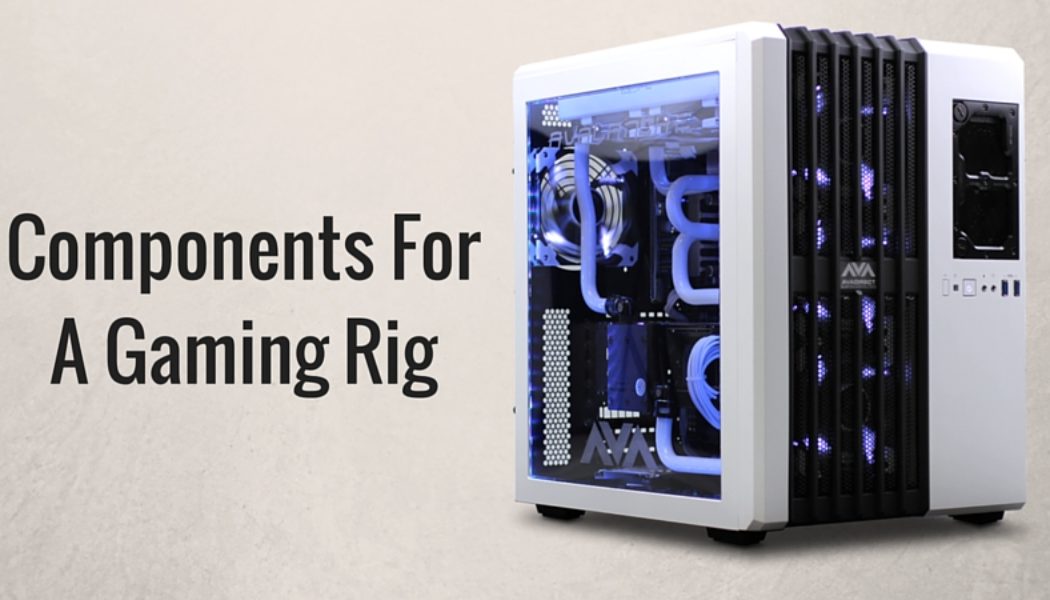There’s never been a better time to be a PC gamer. The gaming scene is vibrant: envelope-pushing graphical powerhouses look best on the PC, and it’s the first stop for independent developers making creative and innovative games. And building a great gaming PC has never been cheaper or easier. But, we admit it, if you’ve never built a PC before, it can still be a little intimidating.
In this article we’ll be discussing what components you’ll need to ensure that you rig is pimped for gaming. We won’t be discussing types of builds, or giving recommendations. That comes in another article. The first step is knowing what the components are, and what function they will perform.
Processor (CPU)
This is the first thing you need to consider, as it is the literal center of your build. The first thing you need to decide is the brand: Intel or AMD? Each has distinct pros and cons: AMD has more cores than Intel, but they are weaker. Intel are the absolute cutting edge as of the time of writing, while AMD’s lineup is busy embodying the phrase “Man, has it really been that long?**”.
All AMD processors can be overclocked right out of the box to a rather obscene degree, while Intel charges a premium for overclockable chips. AMD chips run hotter than Intel’s and consume more power.

Up until two years ago, AMD’s FX8350 was a solid contender to the i5, but now it’s too old. So maybe go with Intel until AMD launches Zen lineup of processors, which is rumoured to have 32 physical cores and 8 channels of DDR4 RAM, against the top dog i7 5960x’s 8 physical/16 hyperthreaded cores and quad channel memory.
Motherboard
This is the second thing to consider for your system, since every component you add will be attached to the motherboard.
The first thing you look at is the socket. If you go AMD, you are gold, as they only have the one: AM3+, but Intel does this scummy thing and changes socket every ‘tick’ (every two generations). Not only that, you also have a plethora of chipsets with specific feature present and absent. Features you might need, like HyperV or more channels for RAM.

Overclocking capability is also to be kept in mind. Not only does your chipset has to be the highest Z- series, but there has to be proper OC support on the motherboard itself. The easiest way to check OC support is to check the heatsink on the motherboard itself: if the northbridge (area around the CPU socket, contains VRMs) has a big and scary looking heatsink, you’re A-OK. Bonus points if there are actual heatpipes in there.
You will also need to decide the size of the build you are looking at since the size of your case depends on the size of your motherboard. Motherboards go from mini ITX and micro ATX to Extended ATX, which changes the number of PCI slots, and therefore the number of expansion cards you can cram onto the motherboard.
Power Supply
SMPS is also critical, and the wattage of your preferred power supply depends on the power draw of your processor and GPU (shown on the box as TDP). There is not much to say here except don’t cheap out: A faulty power supply WILL burn down other components. My last PC’s power supply, a low end branded unit, served me well for 8 years and then blew up, taking with it the motherboard, the processor, the RAM and the GPU, hence killing the entire system.

You will find that PSUs are rated by efficiency, with Platinum rated units scoring a µ of more than 95%. You will also notice that the higher end units are modular, meaning you can remove unneeded wires. This is a godsend if you are a neat freak who absolutely abhors cable mess, or if you’re building in a very small case.
Graphics Card (GPU)
Graphics cards are an anomaly: While absolutely critical in gaming builds, they are an optional expansion in most PCs. The AMD v/s Nvidia dilemma is present here, and I will not touch on that. If you ask me, here’s the bottom line: just go with the highest end model you can afford.

Memory (RAM)
Nothing to see here, a 16GB dual channel kit is sufficient for gaming, while if you want to make videos, the more the merrier.
Storage (HDD or SSD)
Storage depends more on your wallet than your needs: You can go all SSD if you’re rich as hell, or all magnetic if you’re broke. Best bet is a small SSD for critical apps and OS and HDD for games and movies. To gain great understanding of the differences between an SSD and an HDD check out our video here, or if you’re old school, read more here.

Cabinet
Cabinet is a very personal thing and depends on people’s personal taste. For instance, I like flat, minimalist and small cases, while Manas prefers large and aggressive cases. So my advice is do your own digging. And if you’re planning to cheap out on the case, remember that this is the part of the PC you’re going to be staring at for years to come.
**Because they were released in 2011 and that is 5 of Intel’s tick-tock generations ago. So while AMD’s chips are on way older 32nm transistors, the Intel chips have moved to 12 nanometre FinFETs. (Sorry, I’m a computer engineer. I get carried away.)
And for the latest in technology (barely steps behind Google and NASA) keep checking back at Gaming Central.
Posted originally on Pimp My Rig.

